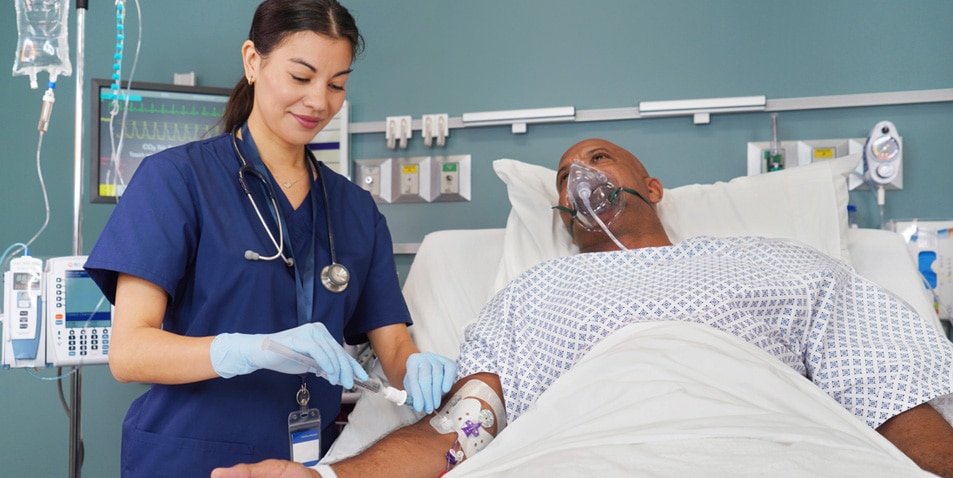Healthcare facilities are continuing to feel the burden from the pandemic with high rates of nursing turnover and shortages...At the same time, hospitals worldwide are still seeing increased rates of preventable catheter-related infections, which can be both dangerous to patients and costly for hospitals. It’s not easy to be a frontline caregiver right now. Nurses need efficient and effective solutions to help them advance IV catheter care while improving the safety of their patients.


- Overview
- Why ‘Scrub the Hub’?
- Products & Accessories
- EIFU & Resources
With an active disinfection unit built into the tip of the syringe, the all-in-one BD PosiFlush™ SafeScrub Prefilled Saline Flush Syringe is demonstrated to significantly reduce microbial growth associated with potentially serious CRBSIs.*
Giving you one more tool to protect your patients and one less thing to worry about.
*In vitro test results may not be predictive of clinical performance. Demonstrated reduction of the most common causative agents of CRBSI including Staphylococcus aureus, Staphylococcus epidermidis, Pseudomonas aeruginosa, Escherichia coli, Candida glabrata and Candida albicans.
-
Demonstrated to reduce microbial growth
Built-in active disinfection unit has been proven via in vitro testing to reduce on average ≥99.99% microbial load of the leading microbes associated with CRBSIs*
-
Designed to reduce touch contamination
All-in-one solution is designed to promote aseptic non-touch technique (ANTTⓇ)
-
Reinforces adherence to evidence-based best practice
Integrated scrubbing device on the tip of the syringe means this important step simply can’t be missed
-
Improves efficiency
Seamless integration of scrubbing into workflow means no more searching for alcohol wipes
*In vitro test results may not be predictive of clinical performance. Demonstrated reduction of the most common causative agents of CRBSI including Staphylococcus aureus, Staphylococcus epidermidis, Pseudomonas aeruginosa, Escherichia coli, Candida glabrata and Candida albicans.

- 1
- 2
- 3
- 4
- 5
Integrated active scrubbing device on the tip of the syringe

Terminally sterilized to 10-6, assuring less than one in a million chance of contamination

Consistent 10 mL syringe barrel diameter, that may help lower the risk of catheter damage due to injection pressure

Clearly-marked bold measurement gradients support efforts to reduce the risk of medication errors by meeting international medication administration guidelines

Stopper design significantly lowers blood reflux⌃


The clinically-proven technology of the BD PosiFlush™ Prefilled Saline Syringe and BD Site-Scrub™ Isopropyl Alcohol (IPA) Device combined to create an innovative, all-in-one active scrub and flush solution—the BD PosiFlush™ SafeScrub Prefilled Saline Flush Syringe.
Why ‘Scrub the Hub’?

Vascular access devices are an integral part of care for many patients—yet the improper care and maintenance of these devices is one of the leading sources of catheter-related bloodstream infections (CRBSIs).1
While hub colonization is the strongest predictor of CRBSI after catheter insertion, compliance to 'scrub the hub' disinfection guidelines is reported to be as low as 10%1
-
Many high-touch hospital surfaces harbored microbes and increased the risk of infection, contaminating as many as 45% of needle-free connectors1,2
-
While the guidelines are clear on the importance of scrubbing the hub before every access, inadequate IV catheter disinfection has been directly linked to CRBSIs1
-
Hospitals are under tremendous pressure due to record nursing turnover and shortages, with 35.8% of hospitals in the United States reporting a nurse vacancy of greater than 10%3,4
-
Due to the influx of new nurses, there is a decline in the experience of the nursing workforce4
Patients and healthcare systems are
feeling the burden

CLABSI rates increased by 53% year-over-year during the COVID-19 pandemic5

CLABSI has an estimated 12-25% mortality rate6

On average, it costs approximately $46,000 to treat one CLABSI patient7
- Moureau NL, Flynn J. Disinfection of needleless connector hubs: Clinical evidence systematic review. Nurs Res Pract. 2015;2015:796762.
- Kaler W. Making it easy for nurses to reduce the risk of CLABSI. Patient Safety & Quality Healthcare. 2014;11(6):46-49.
- Strategies to mitigate healthcare personnel staffing shortages. Center for Disease Control and Prevention. Published 2020. Accessed September 29, 2022. https://www.cdc.gov/coronavirus/2019-ncov/hcp/mitigating-staff-shortages.html.
- Data Brief: Workforce Issues Remain at the Forefront of Pandemic-related Challenges for Hospitals. American Hospital Association. Published January 2022. Accessed September 29, 2022.
- Weiner-Lastinger LM, Pattabiraman V, Konnor RY, et al. The impact of coronavirus disease 2019 (COVID-19) on healthcare-associated infections in 2020: A summary of data reported to the National Healthcare Safety Network [published correction appears in Infect Control Hosp Epidemiol. 2022 Jan;43(1):137].
- Chovanec K, Arsene C, Gomez C, et al. Association of CLABSI With Hospital Length of Stay, Readmission Rates, and Mortality: A Retrospective Review. Worldviews Evid Based Nurs. 2021;18(6):332-338. doi:10.1111/wvn.12548
- Haddadin Y, Annamaraju P, Regunath H. Central Line Associated Blood Stream Infections. In: StatPearls. Treasure Island (FL): StatPearls Publishing; November 26, 2022.
BD-89869 (05/23)
BD-89869 (05/23)
